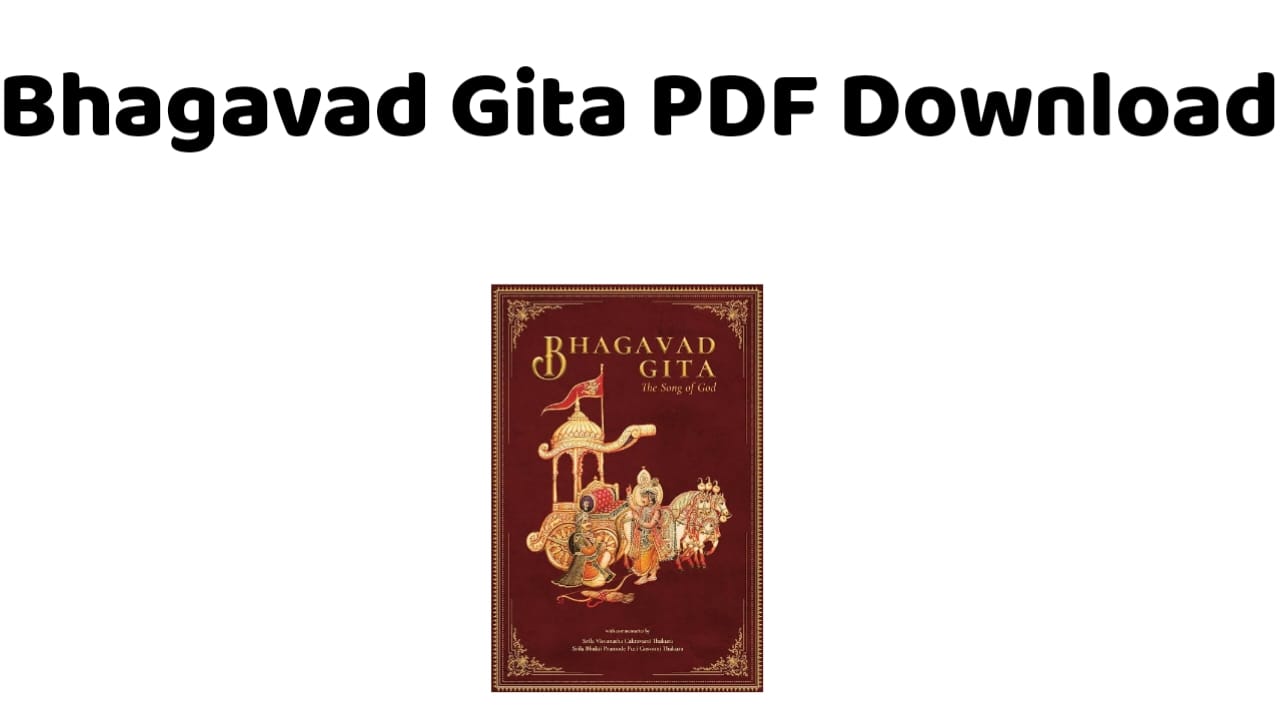Bhagavad Gita PDF Free Download
The Bhagavad Gita is a pivotal dialogue in the ancient Indian epic, Mahabharata. It begins on the battlefield of Kurukshetra, where two rival groups, the Pandavas and the Kauravas, are poised for a great war. As the battle is about to begin, Arjuna, a warrior prince of the Pandavas, is filled with doubt and moral confusion about fighting against his own relatives, teachers, and friends. In his distress, Arjuna turns to Lord Krishna, who serves as his charioteer and guide.
Arjuna seeks Krishna’s counsel on what he should do. In response, Lord Krishna imparts profound spiritual wisdom and reveals his divine form, displaying his cosmic omnipotence. He advises Arjuna to fulfill his duty as a warrior without attachment to the results, emphasizing the concept of selfless action (Karma Yoga).
Krishna expounds on various paths of yoga, including the paths of devotion (Bhakti Yoga), knowledge (Jnana Yoga), and meditation (Dhyana Yoga). He underscores that all these paths ultimately lead to the realization of the eternal nature of the soul (atman) and the oneness with the supreme reality (Brahman).

Throughout the dialogue, Krishna elucidates the nature of the self, the significance of righteous action, and the need for unwavering devotion to God. He encourages Arjuna to rise above his doubts and fears, reminding him of his divine duty as a warrior and urging him to fight for justice and righteousness.
Arjuna gradually gains clarity and surrenders himself to Krishna’s guidance. He resolves to fulfill his duty as a warrior and engage in the battle with determination and resolve.
The Bhagavad Gita concludes with Arjuna acknowledging Krishna’s divine supremacy and committing himself to follow his teachings. The profound wisdom imparted by Lord Krishna to Arjuna serves as a timeless guide to humanity, addressing fundamental questions about life, duty, ethics, and the path to spiritual enlightenment. The Bhagavad Gita remains a source of inspiration and spiritual wisdom for millions, transcending time and cultural boundaries.
Bhagavad Gita PDF Free Download
The Bhagavad Gita, often referred to simply as the Gita, is one of the most important and revered texts in Hindu philosophy and spirituality. It is a 700-verse epic scripture that is part of the Indian epic Mahabharata, specifically within the Bhisma Parva, which is one of the 18 Parvas (books) of the Mahabharata. The Bhagavad Gita is written in the form of a dialogue between Lord Krishna and Prince Arjuna on the battlefield of Kurukshetra.
Here are some key points and important information about the Bhagavad Gita:
- Authorship: The Bhagavad Gita is traditionally attributed to the sage Vyasa, who is also credited with composing the Mahabharata.
- Setting: The dialogue takes place on the battlefield of Kurukshetra just before the great war is about to begin. Arjuna, the warrior prince of the Pandavas, is filled with moral and emotional dilemmas about fighting in the war, as he is faced with the prospect of fighting against his own relatives, teachers, and friends.
- Characters: The main characters in the Bhagavad Gita are Lord Krishna, the eighth incarnation of Lord Vishnu, who serves as Arjuna’s charioteer and guide, and Arjuna, who seeks guidance from Krishna.
- Themes: The central themes of the Bhagavad Gita are duty (dharma), righteousness, the nature of the self (atman), the concept of God (Brahman), devotion (bhakti), yoga, and the paths to spiritual liberation (moksha).
- Paths of Yoga: The Bhagavad Gita describes different paths of yoga, including Karma Yoga (path of selfless action), Bhakti Yoga (path of devotion), Jnana Yoga (path of knowledge and wisdom), and Dhyana Yoga (path of meditation).
- Teachings: Lord Krishna imparts profound spiritual wisdom and guidance to Arjuna. He emphasizes the importance of performing one’s duty without attachment to the results, surrendering to the divine will, and realizing the eternal nature of the soul.
- Universal Appeal: The teachings of the Bhagavad Gita go beyond religious boundaries and have universal appeal. Its insights into the human condition, ethical dilemmas, and the path to spiritual growth make it relevant to people of all backgrounds.
- Influence: The Bhagavad Gita has had a significant impact on Indian philosophy, spirituality, and culture. It has inspired countless scholars, philosophers, leaders, and spiritual seekers throughout history.
- Versatility: Due to its spiritual and philosophical depth, the Bhagavad Gita has been interpreted and commented upon by numerous philosophers and scholars, resulting in a wide range of interpretations and commentaries.
- Timelessness: The teachings of the Bhagavad Gita remain relevant in the contemporary world, addressing timeless questions of human existence, moral choices, and the pursuit of spiritual wisdom.
The Bhagavad Gita continues to be studied, revered, and cherished by millions of people worldwide as a profound source of spiritual wisdom and guidance. It is considered a sacred scripture and a philosophical masterpiece in the realm of Indian and world literature.
Introduction
The Bhagavad Gita, an integral part of the Indian epic Mahabharata, stands as a timeless spiritual guide and philosophical discourse that transcends cultural and religious boundaries. This ancient scripture, though steeped in Hindu philosophy, holds universal appeal due to its profound insights into human existence, duty, and spirituality. In this article, we will explore the Bhagavad Gita with an overview, summary, selected quotes, review, and address some frequently asked questions about this sacred text.
Overview
The Bhagavad Gita, often referred to as the Gita, comprises 700 verses and unfolds in the context of the Kurukshetra War, where two families, the Pandavas and the Kauravas, stand ready to engage in a monumental battle. The protagonist, Prince Arjuna, is overwhelmed with doubt and moral dilemmas about fighting against his own kin. Seeking guidance, he turns to Lord Krishna, his charioteer and confidant, who imparts divine wisdom throughout the dialogue.
Summary
At the heart of the Bhagavad Gita lies the concept of Dharma, the righteous duty, and the eternal struggle between good and evil. As the conversation unfolds, Krishna expounds on various paths to spiritual liberation, urging Arjuna to embrace his duty as a warrior without attachment to the outcomes – a philosophy known as Karma Yoga. He elucidates three prominent paths: Bhakti Yoga (the path of devotion), Jnana Yoga (the path of knowledge), and Dhyana Yoga (the path of meditation).
Key Quotes
- “You have the right to perform your prescribed duties, but you are not entitled to the fruits of your actions.” – Bhagavad Gita 2.47
- “When meditation is mastered, the mind is unwavering like the flame of a lamp in a windless place.” – Bhagavad Gita 6.19
- “I am time, the great destroyer of worlds, and I have come here to destroy all people.” – Bhagavad Gita 11.32
- “Those who are seers of the truth have concluded that of the nonexistent [the material body] there is no endurance and of the eternal [the soul] there is no change.” – Bhagavad Gita 2.16
Review
The Gita has left an indelible mark on humanity, inspiring millions with its timeless teachings. Its profound philosophical insights, coupled with the practical guidance on living a purposeful life, make it a spiritual treasure trove for seekers of all backgrounds. Its emphasis on selfless action and the path to self-realization has garnered universal acclaim.
Also Read This : Sukhmani Sahib PDF Free Download
The Gita’s literary and philosophical brilliance is evident in its narrative structure and its ability to address complex ethical and metaphysical dilemmas. The dialogue between Krishna and Arjuna, set amidst the battlefield’s chaos, symbolizes the eternal struggle between right and wrong, mirroring the challenges faced by individuals in everyday life.
The verses of the Gita resonate deeply, compelling readers to reflect on the nature of existence, the self, and the ultimate reality. The spiritual journey it encapsulates serves as a beacon of hope, guiding individuals towards inner peace and enlightenment.
FAQs (Frequently Asked Questions)
Q1: Is the Bhagavad Gita exclusively for Hindus? A1: While the Bhagavad Gita is a revered Hindu scripture, its teachings extend beyond religious boundaries, appealing to people of various faiths and beliefs. Its universal themes of duty, morality, and self-realization have a profound impact on individuals worldwide.
Q2: How does the Bhagavad Gita influence contemporary life? A2: The Bhagavad Gita offers valuable life lessons and guidance on navigating challenges and making moral choices. Its teachings on self-discipline, devotion, and inner peace remain relevant in modern society.
Q3: Can one practice the teachings of the Bhagavad Gita without renouncing worldly life? A3: Yes, the Bhagavad Gita’s teachings advocate performing one’s duties diligently, without attachment to the results. It emphasizes the integration of spiritual values into everyday life, making it accessible to householders and seekers alike.
Q4: What are the main philosophical concepts of the Bhagavad Gita? A4: The Bhagavad Gita introduces concepts like Dharma (righteous duty), Atman (self or soul), Brahman (supreme reality), Karma (action), and Moksha (liberation). These profound ideas form the foundation of Hindu philosophy and spiritual quest.
Conclusion
With its timeless wisdom, has stood the test of time, guiding humanity on the path of righteousness and self-realization. Its insights into the nature of existence, duty, and spirituality continue to inspire seekers from all walks of life. Regardless of one’s religious background, the Gita’s teachings offer profound insights into the human condition, making it an enduring masterpiece in the realm of world literature and spirituality.





![[ New] CCC Syllabus In Hindi pdf – सीसीसी पाठ्यक्रम की जानकारी हिंदी में](https://www.hindihelpguru.com/wp-content/uploads/2019/07/CCC-Syllabus-In-Hindi.jpg)


